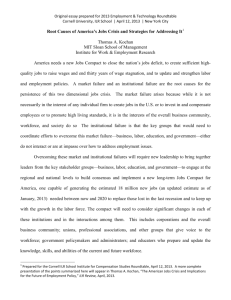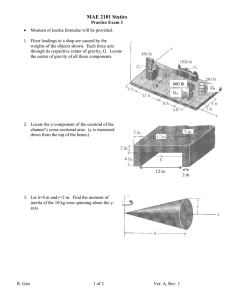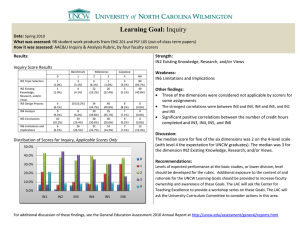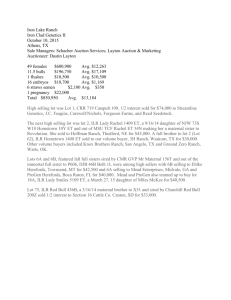Effect of selenium deficiency on the thermoelectric
advertisement
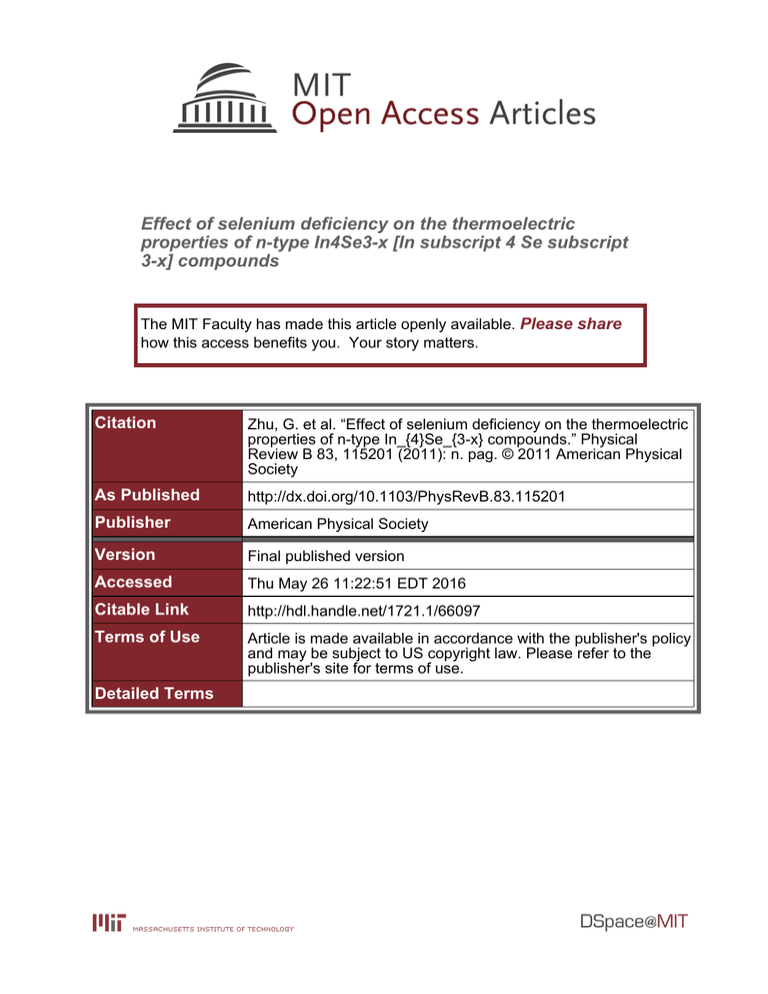
Effect of selenium deficiency on the thermoelectric
properties of n-type In4Se3-x [In subscript 4 Se subscript
3-x] compounds
The MIT Faculty has made this article openly available. Please share
how this access benefits you. Your story matters.
Citation
Zhu, G. et al. “Effect of selenium deficiency on the thermoelectric
properties of n-type In_{4}Se_{3-x} compounds.” Physical
Review B 83, 115201 (2011): n. pag. © 2011 American Physical
Society
As Published
http://dx.doi.org/10.1103/PhysRevB.83.115201
Publisher
American Physical Society
Version
Final published version
Accessed
Thu May 26 11:22:51 EDT 2016
Citable Link
http://hdl.handle.net/1721.1/66097
Terms of Use
Article is made available in accordance with the publisher's policy
and may be subject to US copyright law. Please refer to the
publisher's site for terms of use.
Detailed Terms
PHYSICAL REVIEW B 83, 115201 (2011)
Effect of selenium deficiency on the thermoelectric properties of n-type In4 Se3−x compounds
G. H. Zhu,1 Y. C. Lan,1 H. Wang,1 G. Joshi,1 Q. Hao,2 G. Chen,2,* and Z. F. Ren1,†
1
2
Department of Physics, Boston College, Chestnut Hill, Massachusetts 02467, USA
Department of Mechanical Engineering, Massachusetts Institute of Technology, Cambridge, Massachusetts 02139, USA
(Received 22 November 2010; published 4 March 2011)
Thermoelectric properties of dense bulk polycrystalline In4 Se3−x (x = 0, 0.25, 0.5, 0.65, and 0.8) compounds
are investigated. A peak dimensionless thermoelectric figure of merit (ZT) of about 1 is achieved for x = 0.65
and 0.8. The peak ZT is about 50% higher than the previously reported highest value for polycrystalline In4 Se3−x
compounds. Our In4 Se3−x samples were prepared by ball milling and hot pressing. We show that it is possible to
effectively control the electrical conductivity and thermal conductivity by controlling selenium (Se) deficiency
x. The ZT enhancement is mainly attributed to the thermal conductivity reduction due to the increased phonon
scattering by Se deficiency, defects, and nanoscale inclusions in the ball-milled and hot-pressed dense bulk
In4 Se3−x samples.
DOI: 10.1103/PhysRevB.83.115201
PACS number(s): 72.20.Pa
I. INTRODUCTION
Solid-state energy conversion between heat and electricity
based on thermoelectric effects has attracted extensive interest
for many decades.1 Thermoelectric devices can be used for
environmentally friendly refrigeration and power generation.
The efficiency of thermoelectric devices is determined by a
dimensionless thermoelectric figure of merit ZT = (S 2 σ/κ)T ,
where S, σ , κ, and T are the Seebeck coefficient, electrical
conductivity, thermal conductivity, and absolute temperature,
respectively.1 Considerable effort has been made to improve
the ZT values of the existing thermoelectric materials or
to discover new high ZT materials. Recently, a noticeably
high ZT was achieved in the b-c plane of In4 Se2.35 single
crystals.2 In4 Se3 crystallizes in a layered structure with weak
van der Waals bonding between the layers along the a axis
and strong covalent bonding within the layer (b-c plane).2,3
Due to charge-density wave (CDW) and Peierls distortion,
the thermal conductivity in the b-c plane of the bulk single
crystal In4 Se2.35 is greatly reduced.2 However, In4 Se2.35 single
crystals prepared by the unidirectional crystal-growth method,
such as Bridgeman technology, have remarkable anisotropy.
Although In4 Se2.35 is reported to have a ZT value of 1.48
at 432 ◦ C in the b-c plane, the ZT value in the a-b plane is
much lower, around 0.5 at 432 ◦ C.2 Although polycrystalline
In4 Se3−x compounds do not have an anisotropy problem,
the highest reported ZT is only about 0.6,4,5 which is not
good enough for practical applications. In the past decade,
numerous experimental and theoretical studies have shown that
nanocomposite and nanostucturing approaches are effective in
improving ZT.6–11 In nanostructured systems, the enhanced
ZT comes from a significant reduction in phonon thermal
conductivity. Nanoscale grains and inclusions are believed to
strongly scatter phonons, which have relatively longer mean
free paths than those of the electrons.12–14 We note that In4 Se3
single crystals have relatively high electrical resistivity, and
the thermal conductivity mainly comes from the lattice thermal
conductivity. Thus we applied the ball milling and hot-pressing
approach7–11 to the In4 Se3−x system, expecting to observe
reduced lattice thermal conductivity due to the enhanced
phonon scattering by nanograins and/or nanostructures in
hot-pressed samples. Furthermore, different Se deficiency x
1098-0121/2011/83(11)/115201(4)
in In4 Se3−x samples were prepared so as to optimize the
thermoelectric properties.
II. EXPERIMENT
In our work, different amounts of indium (In) and selenium
(Se) elements were mixed together and pulverized into
nanopowders by ball milling. All weighing and loading of
the materials were operated inside a glove box filled with
argon gas. The nanopowders were hot pressed into discs by a
quick direct-current-induced hot-pressing process at 540 ◦ C.
X-ray diffraction (XRD, Bruker-AXS, D8), scanning electron
microscopy (SEM, JEOL-6340F), and high-resolution transmission electron microscopy (HRTEM, JEOL-2010F) were
used to characterize the nanopowders and hot-pressed bulk
samples. The electrical conductivity and Seebeck coefficient
were measured simultaneously on the same bar samples of
about 2 × 2 × 12 mm in a multiprobe transport system (Ulvac
ZEM-3). The thermal diffusivity (α) was measured using a
laser flash system (Netzsch LFA 457) and the heat capacity
(Cp ) was measured by a commercial differential scanning
calorimeter (DSC 200 F3). The density of the hot-pressed
samples was measured using an Archimedes kit. The density
of our hot-pressed In4 Se3−x (x = 0–0.8) samples is ∼5.93–
6.03 g cm−3 , which is very close to the theoretical value.
The thermal conductivity κ is obtained as the product of
thermal diffusivity (α), sample density (ρ), and heat capacity,
k = αp Cp .
III. DISCUSSION AND CONCLUSIONS
Figure 1 shows the XRD pattern of In4 Se2.35 bulk samples
after hot pressing. The XRD pattern confirms that the major
phase of our samples is the In4 Se3 phase. Since In4 Se3−x
is thermodynamically unstable,15 a weak peaks of indium
impurity phase was also detected in some of the In4 Se3−x
samples.
Figure 2 shows the transport properties of In4 Se3−x samples
with different Se deficiency concentrations (x = 0, 0.25, 0.5,
0.65, and 0.8). The electrical resistivity ρ dependence of
temperature as shown in Fig. 2(a) and the dependence of Se
deficiency x, shown as the inset, indicate that the resistivity first
decreases with increasing Se deficiency concentration up to
115201-1
©2011 American Physical Society
ZHU, LAN, WANG, JOSHI, HAO, CHEN, AND REN
PHYSICAL REVIEW B 83, 115201 (2011)
FIG. 1. XRD pattern of dense bulk samples In4 Se2.35 after hot
pressing.
x = 0.5, then increases with x. With increasing Se deficiency x
from 0 to 0.8, In4 Se3−x samples change conducting behaviors:
In4 Se3 and In4 Se2.2 are semiconductors whereas In4 Se2.5
shows semimetallic behaviors, especially at around room
temperature, with both hole and electron carriers, which results
in a relatively lower electrical resistivity of 1.7 × 10−4 m
at room temperature. The effective carrier concentration n of
In4 Se2.5 , measured by using the van der Pauw method,16 is
1.68 × 1018 cm−3 at 25 ◦ C, almost two orders of magnitude
higher than 4.02 × 1016 cm−3 (In4 Se3 ) and 4.13 × 1016 cm−3
(In4 Se2.2 ). The mobility of In4 Se3−x samples varies from
29.1 cm2 V−1 S−1 (In4 Se2.5 ) to 189 cm2 V−1 S−1 (In4 Se3 ),
which is lower than the reported value.4 The relatively
low mobility in our In4 Se3−x samples is mainly due to the
increased scattering of the charge carriers by the increased
number of grain boundaries and defects in our ball-milled and
hot-pressed samples.
Large negative Seebeck coefficient values are observed
in In4 Se2.2 , In4 Se2.35 , and In4 Se3 samples [Fig. 2(b)]. The
semiconducting In4 Se2.2 sample shows a maximum Seebeck
coefficient of about −560μV K−1 at room temperature,
whereas semimetallic In4 Se2.5 sample shows the lowest Seebeck coefficient of −26μV K−1 at room temperature due to
the existence of both types of carriers. The thermoelectric
power factor (S 2 σ ) is shown in Fig. 2(c). Because of the low
electrical transport properties, S 2 σ values are small for all
In4 Se3−x samples.
Figures 2(d) and 2(f) show the temperature dependence
of the thermal conductivity κ and dimensionless figure of
FIG. 2. (Color online) Temperature-dependent electrical resistivity (a), Seebeck coefficient (b), power factor (c), thermal conductivity (d),
specific heat Cp and diffusivity (e), and ZT (f) of hot-pressed dense bulk samples In4 Se3−x . The inset in (a) shows the electrical resistivity
dependence of Se deficiency.
115201-2
EFFECT OF SELENIUM DEFICIENCY ON THE . . .
PHYSICAL REVIEW B 83, 115201 (2011)
merit ZT. As shown in Fig. 2(d), the thermal conductivity κ
decreases from 0.75W m−1 K−1 to 0.41W m−1 K−1 at 425 ◦ C
with increasing temperature for In4 Se2.2 , which has the lowest
thermal conductivity among all samples, about 40% lower than
the reported value in the polycrystalline In4 Se3−x compounds.4
The low thermal conductivity in our In4 Se3−x samples should
be attributed to the defect-induced phonon scattering by the
Se deficiency sites and enhanced phonon scattering due to the
higher grain-boundary density. Figure 2(e) shows the thermal
diffusivity and specific-heat capacity values of In4 Se3−x
samples. Very low diffusivity values are observed in all
In4 Se3−x samples and the diffusivity decreases with increasing
Se deficiency in the high-temperature region, indicating strong
phonon scattering by Se vacant sites. ZT [Fig. 2(f)] increases
with temperature and reaches the maximum value at 425 ◦ C.
Owing to the significantly reduced thermal conductivity, the
hot-pressed In4 Se3−x samples exhibit peak ZT values of
0.97 and 0.96 at 425 ◦ C for In4 Se2.2 and In4 Se2.35 samples,
respectively.
In order to understand the mechanism of the thermal
conductivity reduction and ZT enhancement in the hot-pressed
In4 Se3−x samples, preliminary TEM studies were carried out.
The TEM specimens were prepared by both focused ion
beam (FIB) using the standard H-bar method and mechanical
polishing down to several microns using tripod polishing
technique, then Ar+ ion milling using Gatan precision ion
polishing system (PIPS). Unfortunately it turned out that the
sample preparation is very challenging; the specimens were
very easily contaminated. It seems that the contamination was
caused by the materials decomposition and recrystallization
on the specimen surface during the FIB and ion-milling
process. Figure 3(a) shows a typical TEM image of the
ion-milled TEM specimens for In4 Se2.2 from which we can
clearly see that the average grain size is about 400–700 nm,
due to the grain growth during the hot-pressing process.
Although the grain size is much smaller than the conventional
polycrystalline compounds, they are still too big to effectively
scatter phonons and cannot be the reason to explain the
low thermal conductivity in Fig. 2(d). In order to study the
microstructures of the grains by HRTEM, a clean specimen
was carefully mechanically polished to electron transparency
without using Ar+ ion milling to prevent contamination. The
TEM specimen prepared in such a way is clean without
any contamination, but the area which is thin enough for
HRTEM is rather small. HRTEM of the In4 Se2.2 specimen
[Fig. 3(b)] shows that there are some nanoscale features of
sizes up to 10 nm inside the grains. The energy dispersive
x-ray spectroscopy (EDS) result shows that the nanoscale
inclusions have the same composition with the nearby matrix
within EDS experimental error (±1 atm %). Moreover, we also
noticed that there are many dislocations and point defects in our
hot-pressed samples. In order to investigate the dislocations in
the specimens, the fast-Fourier-transform (FFT) of HRTEM
images are generated using the DigitalMicrograph software
(Gatan Inc., PA). A series of inverse fast-Fourier-transformed
(IFFT) images are reconstructed from mask-applied FFT of
HRTEM images. The dislocations distinguished as lattice
discontinuities are directly observed from these reconstructed
IFFT images. The estimated dislocation density (ND ) is higher
than 1012 cm−2 . The relatively low mobility measured in
FIG. 3. (a) Low magnification TEM image of the typical hotpressed In4 Se3−x samples and (b) nanoscale inclusions found in highresolution images.
the hot-pressed In4 Se3−x samples should result from the
high density of dislocations and point defects. We believe
that the increased grain-boundary density, dislocation density,
nanoscale inclusions, and, especially, the Se vacant sites all
contribute to the reduced phonon thermal conductivity κph .
A couple of interesting things need to be pointed out for this
material system: (i) the electrical conductivity in the range of
2 × 102 –6 × 103 Sm−1 is too low for the materials to be good
thermoelectric materials with very high ZT so there is much
room for improvement in ZT if a suitable dopant can be found
to significantly increase the electrical conductivity without too
much affecting the Seebeck coefficient, and (ii) the conducting
behavior change from semiconducting to semimetallic with the
Se deficiency deserves further detailed studies.
Dense bulk In4 Se3−x samples with different Se deficiencies
were prepared by ball milling and hot pressing. Semimetallic
behavior was observed when the Se deficiency x is close
to 0.5. High Se deficiency (x = 0.65 and 0.8) does not
115201-3
ZHU, LAN, WANG, JOSHI, HAO, CHEN, AND REN
PHYSICAL REVIEW B 83, 115201 (2011)
deteriorate the electrical properties, but rather reduces the
thermal conductivity, resulting in improved ZT values. A peak
ZT of about 1 is achieved in In4 Se2.2 at 425 ◦ C, which is
about 50% higher than the previously reported highest value
for polycrystalline samples. This ZT enhancement mainly
comes from the reduction of thermal conductivity due to the
increased phonon scattering by high Se deficiency, defects,
and nanoscale inclusions.
*
†
gchen2@mit.edu
renzh@bc.edu
1
C. Wood, Rep. Prog. Phys. 51, 459 (1988).
2
J. Rhyee, K. H. Lee, S. M. Lee, E. Cho, S. I. Kim, E. Lee,
Y. S. Kwon, J. H. Shim, and G. Kotliar, Nature (London) 459,
965 (2009).
3
Y. B. Losovyj, M. Klinke, E. Cai, I. Rodriguez, J. Zhang,
L. Makinistian, A. G. Petukhov, E. A. Albanesi, P. Galiy,
Y. Fiyala, J. Liu, and P. A. Dowben, Appl. Phys. Lett. 92, 122107
(2008).
4
J. Rhyee, E. Cho, K. H. Lee, S. M. Lee, S. I. Kim, H. Kim, Y. S.
Kwon, and S. J. Kim, Appl. Phys. Lett. 95, 212106 (2009).
5
X. Shi, J. Y. Cho, J. R. Salvador, J. Yang, and H. Wang, Appl. Phys.
Lett. 96, 162108 (2010).
6
K. F. Hsu, S. Loo, F. Guo, W. Chen, J. S. Dyck, C. Uher, T. Hogan,
E. K. Polychroniadis, and M. G. Kanatzidis, Science 303, 818
(2004).
7
B. Poudel, Q. Hao, Y. Ma, Y. C. Lan, A. Minnich, B. Yu, X. Yan,
D. Z. Wang, A. Muto, D. Vashaee, X. Chen, J. M. Liu, M. S.
Dresselhaus, G. Chen, and Z. F. Ren, Science 320, 634 (2008).
ACKNOWLEDGMENTS
The work was funded by the US Department of Energy
under Contract No. DOE DE-FG02-00ER45805 (Z.F.R.),
and Solid State Solar-Thermal Energy Conversion Center
(S3 TEC), an Energy Frontier Research Center funded by the
US Department of Energy, Office of Science, Office of Basic
Energy Sciences, under Award No. DE-SC0001299 (G.C. and
Z.F.R.).
8
Yi Ma, Qing Hao, Bed Poudel, Yucheng Lan, Bo Yu, Dezhi Wang,
Gang Chen, and Z. F. Ren, Nano Lett. 8, 2580 (2008).
9
G. Joshi, H. Lee, Y. C. Lan, X. W. Wang, G. H. Zhu, D. Z. Wang,
A. J. Muto, M. Y. Tang, M. S. Dresselhaus, G. Chen, and Z. F. Ren,
Nano Lett. 8, 4670 (2008).
10
X. W. Wang, H. Lee, Y. C. Lan, G. H. Zhu, G. Joshi, D. Z.
Wang, J. Yang, A. J. Muto, M. Y. Tang, J. Klatsky, S. Song, M. S.
Dresselhaus, G. Chen, and Z. F. Ren, Appl. Phys. Lett. 93, 193121
(2008).
11
G. H. Zhu, H. Lee, Y. C. Lan, X. W. Wang, G. Joshi, D. Z. Wang,
J. Yang, D. Vashaee, H. Guilbert, A. Pillitteri, M. S. Dresselhaus, G. Chen, and Z. F. Ren, Phys. Rev. Lett. 102, 196803
(2009).
12
G. Chen, Semicond. Semimet. 71, 203 (2001).
13
M. S. Dresselhaus, G. Chen, Z. F. Ren, J. P. Fleurial, and P. Gogna,
Adv. Mater. 19, 1043 (2007).
14
A. Majumdar, Science 303, 777 (2004).
15
H. Okamoto, J. Phase Equilibria Diffus. 25, 201 (2004).
16
C. Wood, A. Lockwood, A. Chmielewski, J. Parker, and A. Zoltan,
Rev. Sci. Instrum. 55, 110 (1984).
115201-4
